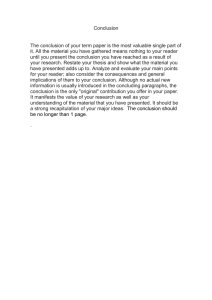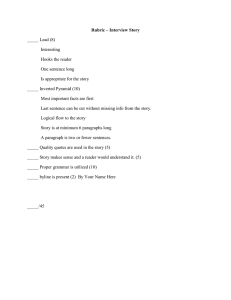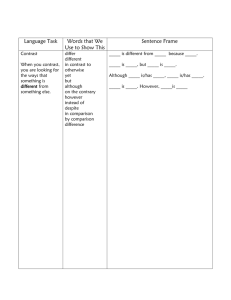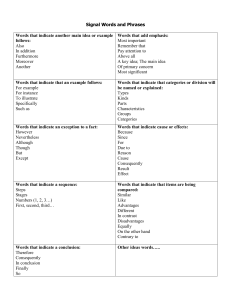Guide to Transition Signals in Writing
advertisement
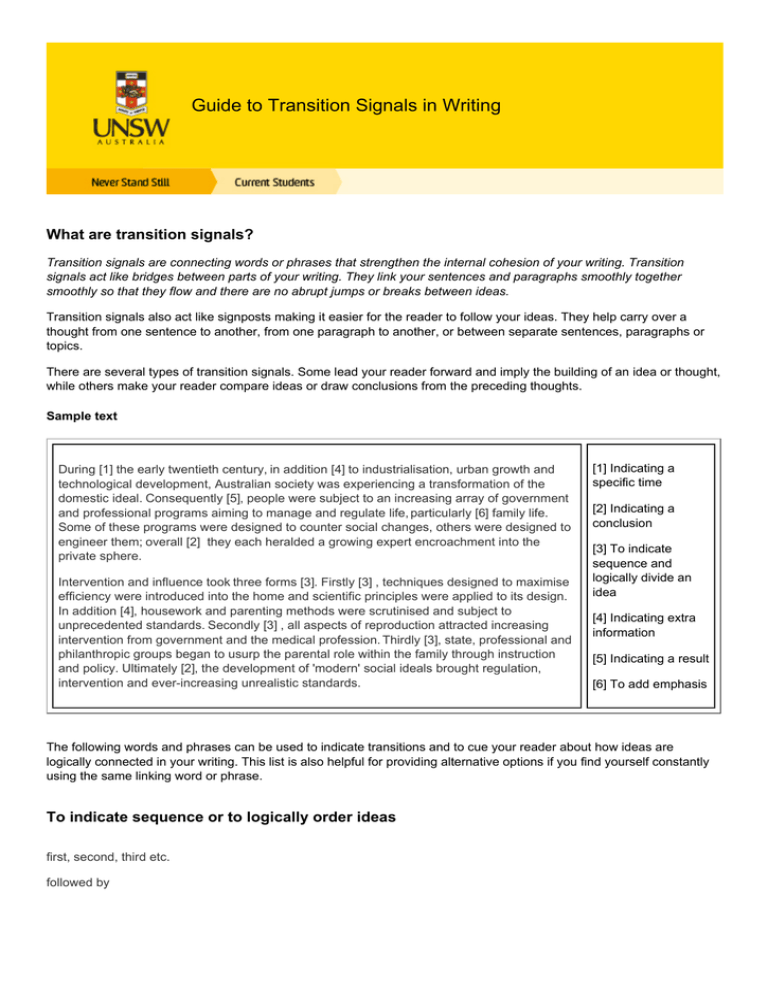
Guide to Transition Signals in Writing What are transition signals? Transition signals are connecting words or phrases that strengthen the internal cohesion of your writing. Transition signals act like bridges between parts of your writing. They link your sentences and paragraphs smoothly together smoothly so that they flow and there are no abrupt jumps or breaks between ideas. Transition signals also act like signposts making it easier for the reader to follow your ideas. They help carry over a thought from one sentence to another, from one paragraph to another, or between separate sentences, paragraphs or topics. There are several types of transition signals. Some lead your reader forward and imply the building of an idea or thought, while others make your reader compare ideas or draw conclusions from the preceding thoughts. Sample text During [1] the early twentieth century, in addition [4] to industrialisation, urban growth and technological development, Australian society was experiencing a transformation of the domestic ideal. Consequently [5], people were subject to an increasing array of government and professional programs aiming to manage and regulate life, particularly [6] family life. Some of these programs were designed to counter social changes, others were designed to engineer them; overall [2] they each heralded a growing expert encroachment into the private sphere. Intervention and influence took three forms [3]. Firstly [3] , techniques designed to maximise efficiency were introduced into the home and scientific principles were applied to its design. In addition [4], housework and parenting methods were scrutinised and subject to unprecedented standards. Secondly [3] , all aspects of reproduction attracted increasing intervention from government and the medical profession. Thirdly [3], state, professional and philanthropic groups began to usurp the parental role within the family through instruction and policy. Ultimately [2], the development of 'modern' social ideals brought regulation, intervention and ever-increasing unrealistic standards. [1] Indicating a specific time [2] Indicating a conclusion [3] To indicate sequence and logically divide an idea [4] Indicating extra information [5] Indicating a result [6] To add emphasis The following words and phrases can be used to indicate transitions and to cue your reader about how ideas are logically connected in your writing. This list is also helpful for providing alternative options if you find yourself constantly using the same linking word or phrase. To indicate sequence or to logically order ideas first, second, third etc. followed by then before, after next, finally previously, subsequently initially, followed by concurrently at that time To refer to a specific incident or example for example to illustrate for instance in the case of case specifically namely in this case such as on this occasion notably To provide emphasis or indicate importance indeed above all especially particularly crucially To indicate time thereafter initially at that/ this point immediately finally simultaneously before, after then, later at that/ this time formerly meanwhile prior to previously during at present To compare and/ or contrast To compare: on the one hand conversely while similarly correspondingly whereas in the same way similar to To contrast: in contrast on the other hand unlike a different view is on the contrary differing from however balanced against by/ in comparison (and) yet To indicate result or cause and effect as a result (of this) consequently as a consequence therefore thus hence accordingly for this reason because (of this) so much (so) that To introduce a similar idea similarly equally in the same way likewise To add another idea or more information in addition furthermore besides also it could also be said additionally another further moreover To introduce an opposite idea, to show exception or concession alternatively however on the other hand it could also be said that in contrast instead whereas nevertheless despite/ in spite of (this) even though admittedly nonetheless albeit notwithstanding (this) although regardless (of this) (and) yet on the contrary To give an example take the case of for example for instance in this case to demonstrate To identify or clarify that is (to say) namely specifically thus in other words To summarise or conclude finally in brief on the whole overall therefore in conclusion in other words thus consequently as a result ultimately in summary hence to summarise Current Students Guide to Transition Signals in Writing Document Version Date 20/01/2015 UNSW CRICOS Provider Code: 00098G https://student.unsw.edu.au/transition-signals-writing
